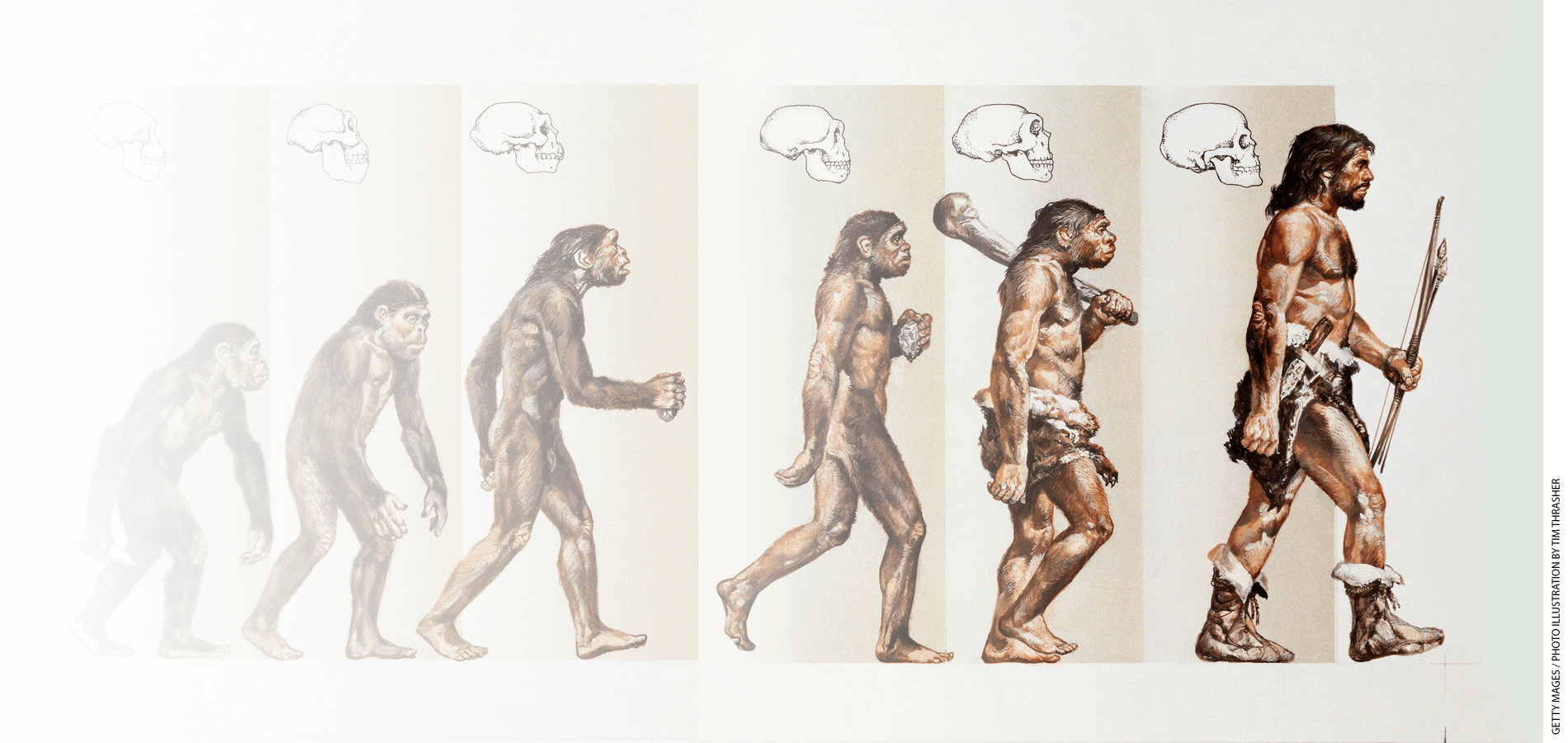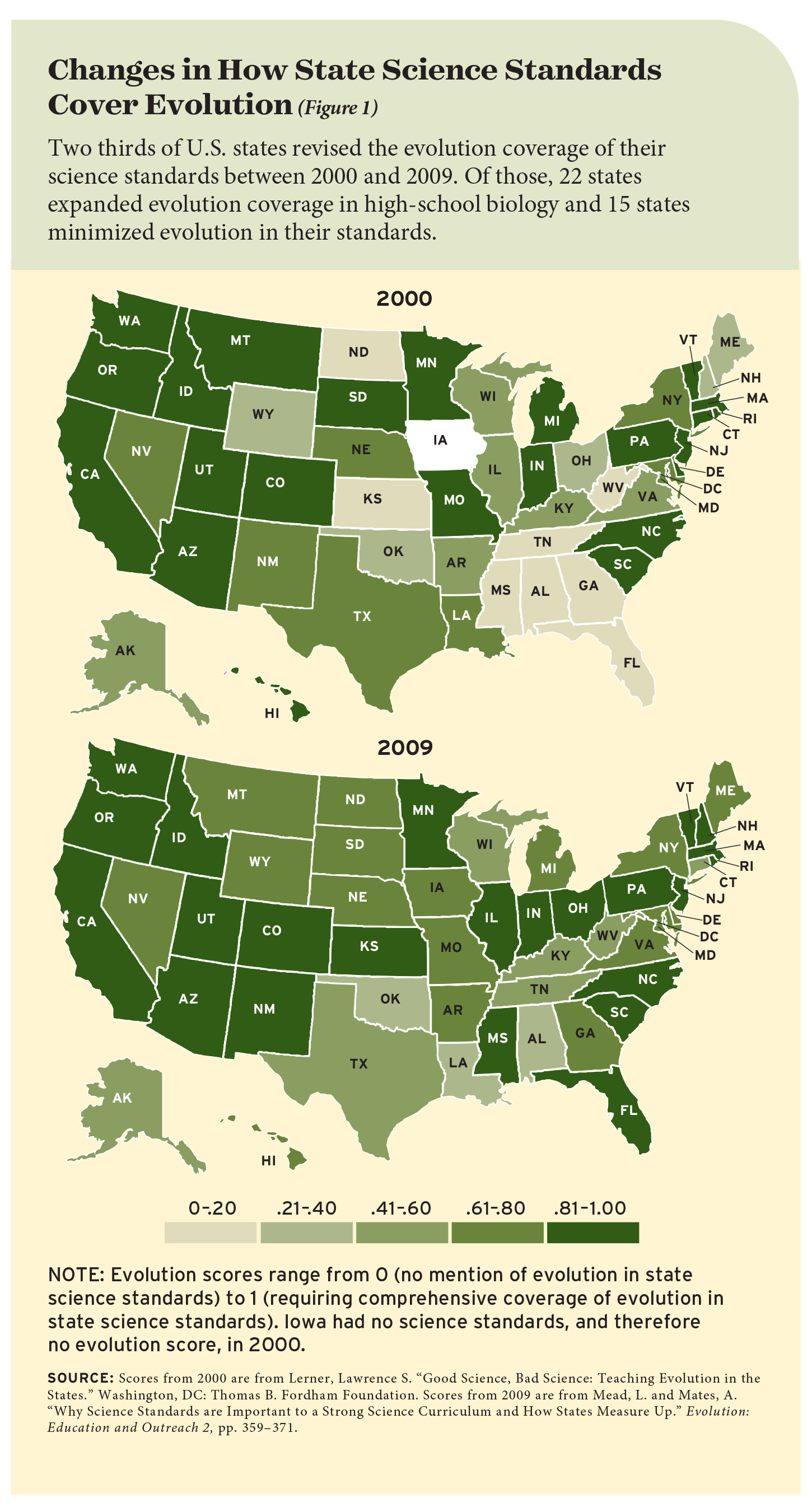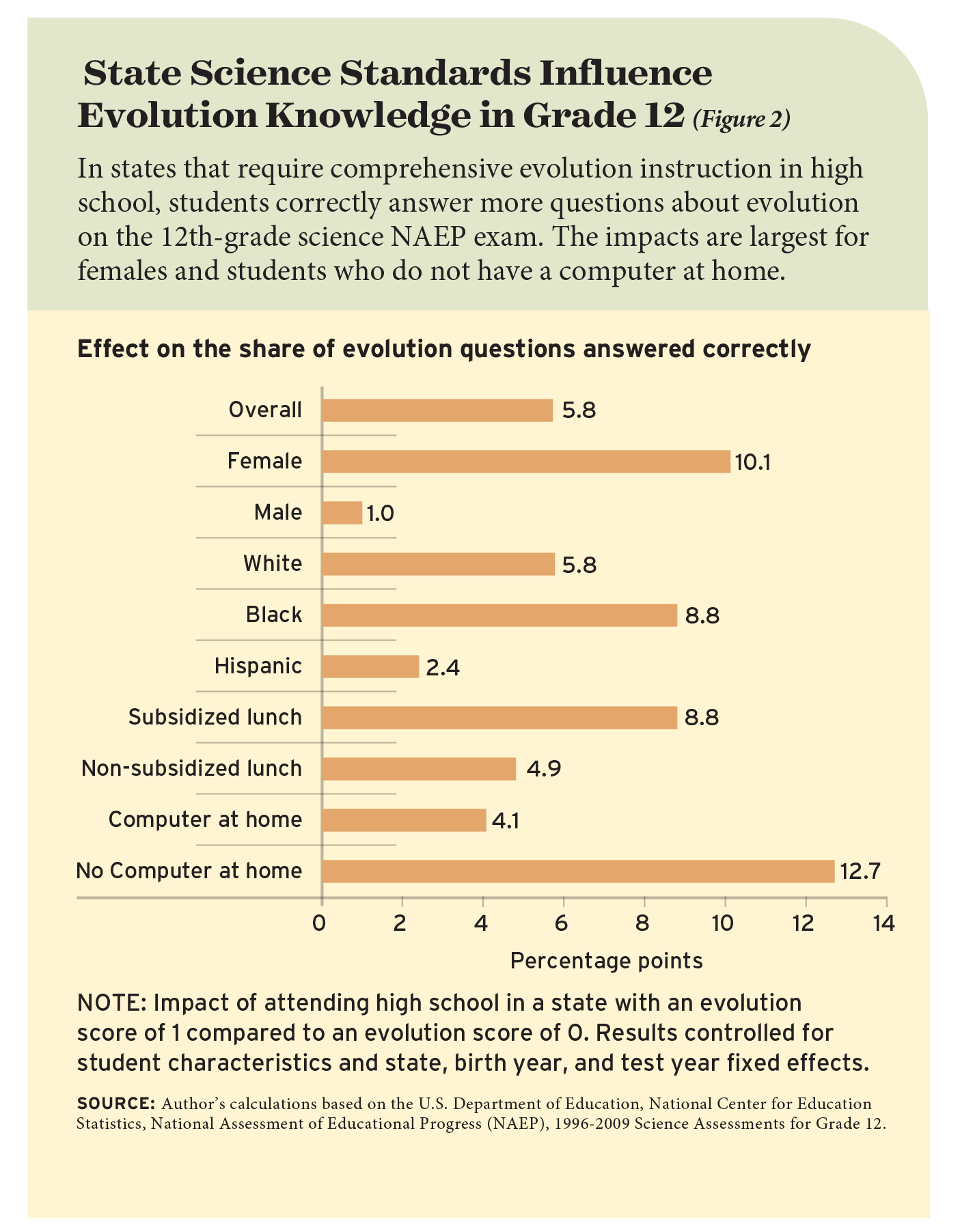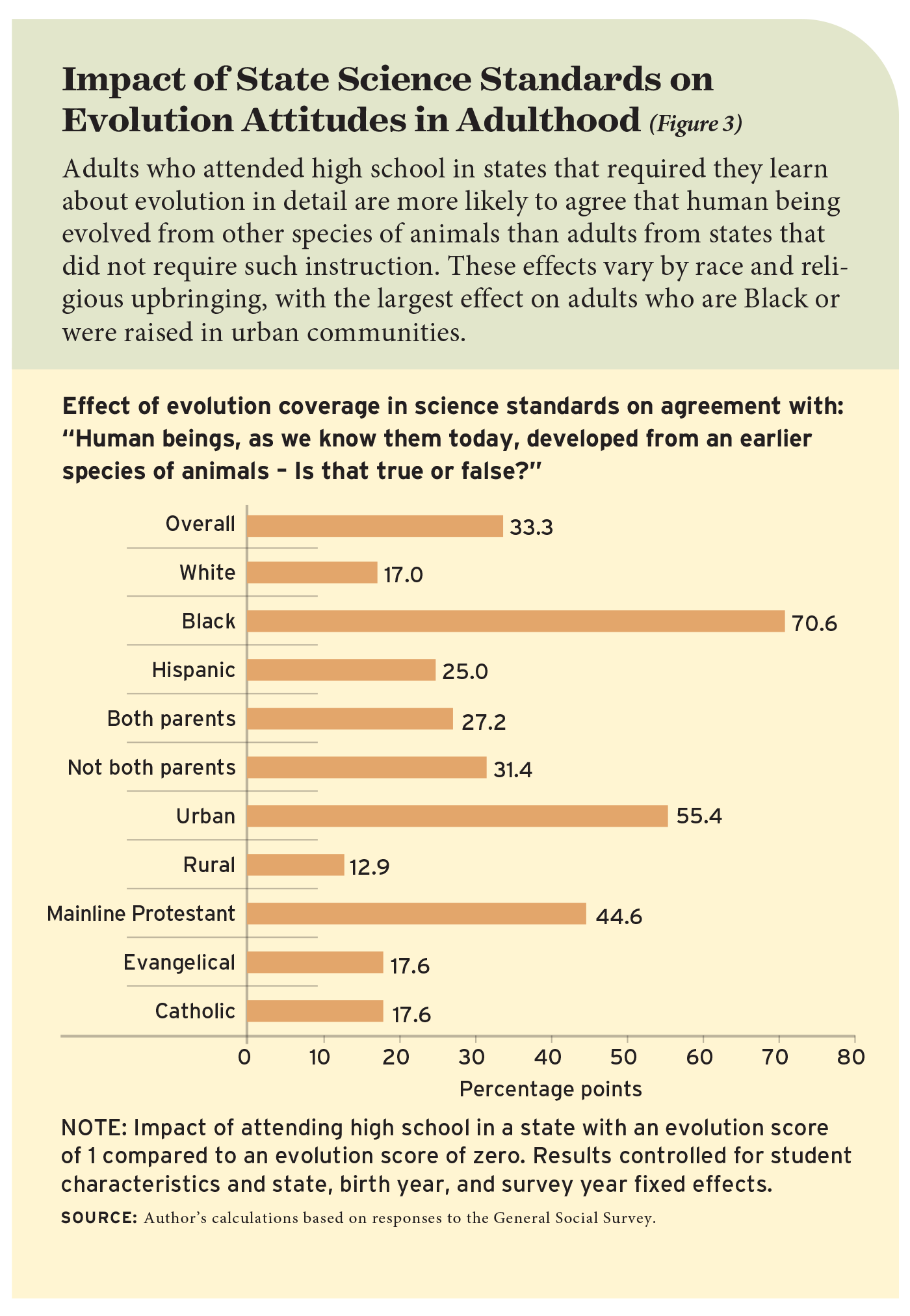
The influence that attitudes about science can have on public health and the economy has been on broad display during the Covid-19 pandemic. Despite consensus in the scientific and medical communities that Covid-19 vaccines are safe and protective against a virus that has killed more than 900,000 Americans, 15 percent of U.S. adults remain unvaccinated. Most report that they don’t trust the vaccines or are worried about side effects. Complicating matters, attitudes about science are closely tracking deeply polarized partisan affiliations. A recent poll found that 34 percent of Republicans reported having a “great deal” of confidence in science compared to 64 percent of Democrats.
What contributes to this skepticism? Virtually every U.S. high-school student is required to study biology, at minimum, to earn a diploma. But the exact content of the course varies from state to state. I investigate the role of state standards for high-school science content in shaping knowledge and attitudes about science—specifically, how inclusion of lessons on evolution theory influences students’ knowledge about evolution at the end of schooling, attitudes on evolution in adulthood, as well as the probability that they work in life sciences.
I focus on evolution theory because it is both foundational to modern science and controversial among Americans. Some 160 years after Charles Darwin’s research detailing the theory of natural selection was first published, 98 percent of scientists compared to 65 percent of U.S. adults believe that humans have evolved, according to the American Association for the Advancement of Science and a 2015 poll by the Pew Research Center. In general, Republicans and evangelical Christians are less likely to agree with the idea that humans evolved over time through natural processes alone, while Democrats and independents are more likely to express agreement with that theory.
There is substantial variation across U.S. states in how evolution is covered in education standards—and the nature of this variation has changed over time. I look at the period of 2000 to 2009. During that timespan, 22 states expanded the coverage of evolution in their education standards and 15 states reduced it. I use these changes to estimate the causal impact of standards on three outcomes: whether students understand evolution theory at the end of high school, agree with evolution theory as adults, and pursue careers in the life sciences.
I find that state science standards affect all three of these outcomes. In states that require more comprehensive evolution instruction, students are more likely to answer knowledge questions on evolution correctly by the end of high school on the National Assessment of Educational Progress. In adulthood, being from a state that requires comprehensive evolution instruction as opposed to no evolution instruction increases evolution approval by 33 percentage points—a 57 percent jump. It also boosts the probability of working in life sciences by 0.04 percentage points, or 23 percent.
My analysis shows that what states require in their educational standards has long-lasting effects on individual attitudes and occupational choices—which, even outside of the challenges of managing a pandemic, can foster innovation, opportunity, and economic growth. When state education leaders require comprehensive instruction in evolution theory in high school, they are helping grow the science workforce of the future.
A Long Battle Over Evolution Education
Whether U.S. public schools should teach evolution has been a contested issue for at least a century. The scientific community reached consensus on the validity of evolution relatively soon after Darwin published On the Origin of Species in 1859, but just one quarter of the biology textbooks published between 1900 and 1919 contained any information about evolution. By the 1920s, about one third of biology textbooks covered human evolution. But the decade also marked the start of a series of legal disputes, with at least 20 states considering bills to ban evolution lessons from public schools.
In Tennessee, the Butler Act banned evolution instruction. That law resulted in the Scopes Trial of 1925. John T. Scopes, a 24-year-old high-school teacher, volunteered to admit he used a textbook that included evolution while covering a biology class in order to be charged with a misdemeanor under the law. After a high-profile trial in which Scopes was represented by the American Civil Liberties Union, he was convicted of violating the Butler Act. While the state supreme court overturned that conviction on a technicality, the justices upheld the Butler Act, and Mississippi and Arkansas soon passed similar laws. These laws remained on the books until 1967, when Tennessee lawmakers repealed the Butler Act, and 1968, when the U.S. Supreme Court’s ruling in Epperson v. Arkansas made such laws unconstitutional on First Amendment grounds.
Efforts to limit evolution teaching persisted in the years following Epperson, with advocates lobbying states to pass bills that required teaching creation theory alongside evolution. Arkansas passed such a “balanced treatment” law in 1981, which was overturned by the U.S. Supreme Court the following year in McLean v. Arkansas Board of Education. In 2007, a nationally representative survey of high-school biology teachers by researchers at Penn State found that just 51 percent said they presented evolution as scientific consensus. That percentage climbed to 67 percent in 2019, though organized efforts to influence how schools cover evolution persist.
“Academic freedom” bills, proposed in states like Florida, Oklahoma, and Arizona, would empower parents to challenge what is taught in school and require teachers to present an array of theories about the origin of life, climate change, and other issues. And in Texas, Governor Greg Abbott’s proposed amendment to the state constitution would establish a “Parents’ Bill of Rights,” including the right to review all curriculum and books teachers plan to use in the classroom. While the current conversation about such proposals is more explicitly focused on how race, gender, and climate change are taught, these bills could have broad implications for the teaching of evolution as well.

Shifts in State Science Standards
In the distant past, curriculum in American public schools was determined largely at the local level. However, concerns about declining achievement among U.S. students in the 1960s and 1970s prompted calls for states to establish rigorous and comparable education standards. In the 1990s, the American Association for the Advancement of Science and National Research Council published guidelines for science standards, which define the scientific knowledge and skills students are supposed to master in each grade in public schools.
State standards are just one of many factors that shape academic content. For example, local school curricula, the selection of textbooks, the knowledge, ability, and ideology of teachers, and testing requirements also influence what students learn in school. However, standards influence how local curricula and lesson plans are written and what content is tested in statewide exams.
Standards are typically drafted by advisory committees, which can consist of a panel of teachers and other stakeholders including, at least occasionally, scientists. The standards then must be considered by a state’s board of education, whose members are either appointed by the governor, elected, or some combination of the two. A board typically holds public hearings and reviews written testimony from parents, scientists, and representatives from religious groups, among others. Then, after this period of public comment, the board votes to approve or reject the proposed standards.
The political process described above implies that changes in standards are not random events. Rather, these changes reflect changing political views, either expressed by the election of a governor who subsequently appoints members of the state board or by the direct election of its members. But the exact point in time that a state’s standards change could be regarded as virtually random. If public approval of teaching evolution or of science in general changes in a given year, that will not necessarily result in a reform of state science standards within a certain amount of time. State by state, board members arrive at their posts through different avenues and serve for different amounts of time. Gubernatorial and legislative election schedules are also not standard from state to state. Further, a state could be influenced by standards changes in other states, due to their influence on public opinion, textbook content, or political will.
One thing that is constant across states is that changes to standards involving evolution typically follow heated negotiations. For example, after years of debate and drafting, in February 2008 the Florida Board of Education voted 4-to-3 in favor of new science standards that included a comprehensive discussion of evolution, replacing standards that did not mention the word “evolution” and included minimal discussion of evolutionary processes. Meanwhile, in 2009 the Texas Board of Education minimized evolution in its standards. A former chairman of the board, who said he did not personally believe in Darwin’s evolution theory, had pushed to limit evolution instruction in various ways. One proposal for state science standards would have required teachers to cover the “strengths and weaknesses” of evolution, while another would have required students to study the “sufficiency or insufficiency” of key principles of evolution. Ultimately, a version of science standards that included evolution without such qualifications but left out statements like “the estimated age of the universe was 14 billion years” was approved.
Notably, the reforms in Florida and Texas did not follow a partisan change—every governor in Florida and Texas in the 21st century was elected as a Republican. Both examples shed light on the political process behind such reforms and show that they are not simply a consequence of a change of government. Because these changes happen at some point in time for largely idiosyncratic reasons, and not because of a specific event like a shift in political power, they are useful for studying how standards affect student outcomes.
Data and Method
First, to measure the coverage of evolution in a state’s science standards, I make use of states’ “evolution scores” as calculated by Lawrence Lerner and Louise S. Mead and Anton Mates, who undertook detailed reviews of state science standards in 2000 and 2009. Those analyses also look at whether (and when) a state’s standards were updated between those years.
The evolution score is a composite index based on whether the word “evolution” appears in a state’s science standards; the respective coverages of biological, human, geological, and cosmological evolution; and the connections drawn between different aspects of evolution. In addition, the index takes into account the absence of creationist jargon and creationist disclaimers in approved textbooks, where applicable. Evolution scores range from 0 to 1, with 0 indicating no mention or a non-scientific creationist view of evolution and a score of 1 indicating comprehensive coverage of evolution. According to Lerner, scores between 0.60 and 0.79 are “satisfactory.” There is wide variation in how standards emphasize alleged weaknesses and critiques of evolution theory.
I compare state scores in 2000 with those from 2009 and find broad changes. Some 22 states earned higher evolution scores because their standards grew more comprehensive, while 15 states earned lower evolution scores because their standards contracted (see Figure 1). Kansas, Mississippi, and Florida had the largest increases in evolution scores, while the biggest decreases were in Connecticut, Louisiana, and Texas.

Second, to estimate the effect of students’ exposure to the teaching of evolution in high school on their knowledge about evolution by the end of high school, I link states’ evolution scores to individual scores on the National Assessment of Educational Progress 12th-grade science test, which includes questions about evolution. I consider scores for students based on their assumed date of high-school entry, three years before they take the test. The high-school entry year is the relevant year, as most teaching of evolution takes place at the beginning of high school. The average evolution score is 0.65, implying that students in the sample were on average exposed to “satisfactory” evolution coverage. Students on average answer just 32 percent of the evolution questions correctly, underscoring the questions’ difficulty.
Third, I link states’ evolution scores to individual results on the General Social Survey conducted by NORC at the University of Chicago. The survey monitors societal change by interviewing nationally representative samples of adults and has included questions about evolution attitudes since 2006. The main outcome variable is based on the question “Human beings, as we know them today, developed from earlier species of animals. Is that true or false?” The data include respondents’ birth years and state of residence at age 16, which allows me to estimate the effect of students’ exposure to the teaching of evolution in high school on their approval of evolution in adulthood.
Finally, I link state evolution scores with occupational fields of adults as reported in the American Community Survey by the U.S. Census Bureau. These data also include year and state of birth; I assume that students enter high school in this state at age 14 and assign the evolution score for this state-year combination accordingly. Since evolution is the fundamental theory of life sciences, I focus primarily on whether adults work in the life sciences.
To study the effects of state standards on these outcomes, I compare students who attended high school in the same state before and after standards changed. This approach addresses the concern that states with more comprehensive standards differ in other ways that matter for student’s knowledge about evolution. I also adjust for differences in a range of individual characteristics that could be associated with the outcomes, such as gender, race, parental education, and the religion in which the student was raised. (The specific set of control variables differs across outcomes based on the available data.) Finally, I take into account the year each student entered high school and the year the outcome data was gathered, in order to capture changes in these outcomes over time across the nation as whole.

Results
In states where science standards call for more comprehensive coverage of evolution in high-school science classes, students accurately answer more questions about evolution on the 12th-grade NAEP science test (see Figure 2). Being from a state with an evolution score of 1, compared to an evolution score of 0, increases the average share of questions on evolution answered correctly by 5.8 percentage points, an 18 percent increase over the average of 32 percent correct. Looking across student subgroups, I find a large difference in effects for females, at 10.1 percentage points, compared to effects for males, at 1.0 percentage points. The largest effects are for students who do not have a computer at home, at 12.7 percentage points. The effects are 8.8 percentage points for both students who are Black and students who do not have a computer at home.
Interestingly, there are no effects on knowledge in areas of science unrelated to evolution. This finding implies that evolution instruction does not spill over to other science areas. It also suggests that the changes in state standards on evolution I use to study the standards’ effects are not associated with changes that matter for students’ broader scientific knowledge.
Scientific content in high school also shapes students’ attitudes in adulthood. Individuals who attended high school in a state with an evolution score of 1, as opposed to an evolution score of 0, are 33.3 percentage points more likely to approve of evolution in adulthood, a 57 percent increase (see Figure 3).

To put this overall effect in context, I look at the impact of state science standards on adult attitudes for groups of students defined based on race, community type, and religious upbringing. The effect is particularly large for Black adults, at 70.6 percentage points, and for adults who were raised in urban communities. Among religious groups, the effect is largest for individuals raised as Mainline Protestants. They are 44.6 percentage points more likely to agree that human evolution is true if they attended high school in a state with an evolution score of 1 as opposed to an evolution score of 0. The impact is 17.6 percentage points for both adults raised Evangelical Christian or Catholic. However, baseline attitudes about evolution among those two groups vary widely: compared to adults raised in non-religious households, adults who were raised as Evangelical Christians are 29 percentage points less likely to agree that human evolution is true, while Catholics are just 1.9 percentage points less likely to agree, conditional on other factors such as gender, race, and parental education.
At the same time, non-evolution scientific, religious, and political attitudes are not affected by evolution instruction. This again shows that the changes in state evolution standards do not affect outcomes in these domains and that the specific timing of the reforms I study is unrelated to general scientific, religious, and political shocks.
Finally, I look at whether state science standards influence whether students pursue careers in the sciences as adults. Being exposed to a comprehensive teaching of evolution as opposed to no evolution teaching when entering high school increases by 0.04 percentage points the probability of working in life sciences in adulthood, which includes typically high-paid occupations in medicine, biology, chemistry, and agriculture. This represents a 23 percent increase, as only 0.15 percent of all adults work in one of these fields. The effects are strongest on careers in biology, for which evolution theory is the fundamental scientific explanation of the origin of life.
At the same time, I find no effect on whether students go on to work in scientific occupations outside the natural sciences, such as jobs in the social sciences or as science technicians, and no effect on whether they pursue work in non-scientific occupations.
Standards Matter
Public debate over academic standards often focuses on the gap between standards and curriculum and emphasizes the critical role that textbook developers, chief academic officers, and teachers play in determining what content is presented to students. The notion that education standards have no meaningful impact on students is a common view. However, legal pressures on school districts, the reflection of the content of education standards in textbooks, and the gradual expansion of standardized testing covering the content of education standards have arguably incentivized teachers to follow standards. My analysis demonstrates that these standards indeed affect what students learn.
More broadly, I find that the content of school curricula and instruction lastingly shapes students—even when it comes to a politically contentious topic like evolution. In particular, when state science standards require that schools teach evolution theory in detail, students know more about evolution at the end of high school. As adults, they are more likely to agree that it is an accurate description of the origins of the human species and to pursue careers in life sciences.
I see broad implications for these findings. For example, state standards that call for more comprehensive instruction about climate change could have analogous effects on student knowledge and adult attitudes and career decisions. Similarly, standards that include detailed coverage of the history and mechanics behind vaccinations could influence knowledge, attitudes, and life choices.
These findings are of particular interest as the U.S. enters the third year of a deadly pandemic. The potential of state standards to enhance public trust in science is a worthy topic of future research.
Benjamin W. Arold is PhD Candidate in economics at LMU Munich and a junior economist at the ifo Center for the Economics of Education at the CESifo Group in Munich, Germany.
This article appeared in the Summer 2022 issue of Education Next. Suggested citation format:
Arold, B.W. (2022). The Costs of Canceling Darwin: Fewer scientists, more skepticism of science in states that limit evolution instruction. Education Next, 22(3), 56-63.


